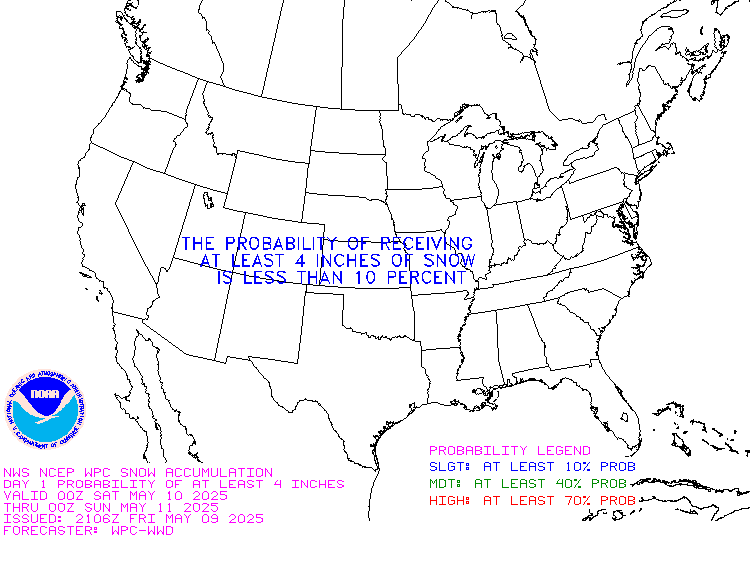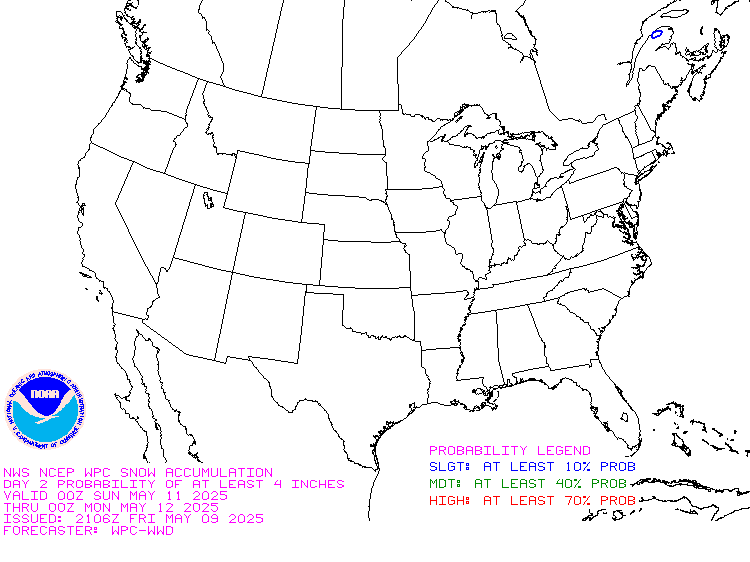It is difficult to find a more comprehensive Weather Outlook anywhere else with the ability to get a local 10-day Forecast also.
This article focuses on what we are paying attention to in the next 48 to 72 hours. The article also includes weather maps for longer-term U.S. outlooks and a six-day World weather outlook which can be very useful for travelers.
First the NWS Short Range Forecast. The afternoon NWS text update can be found here but it is unlikely to have changed very much. The images in this article automatically update.
Short Range Forecast Discussion
NWS Weather Prediction Center College Park MD
Mon Mar 11 2024
Valid 12Z Mon Mar 11 2024 – 12Z Wed Mar 13 2024…Heavy wet snow will continue into the morning hours on Monday across
the higher elevations of the northern New England and portions of the
lower Great Lakes……Unsettled weather is expected to persist across the Pacific Northwest
and into the northern Rockies with multiple rounds of lower-elevation rain
and higher elevation snow……Fire danger to increase across the central and southern High Plains
from very dry conditions, gusty winds, and warm temperatures…A deep low pressure system centered over Downeast Maine early this morning
will be slow to move away into the Canadian Maritimes. The ongoing heavy
wet snow associated with this system is expected to linger across the
higher terrain from the Adirondacks of New York, up across the Green and
White Mountains of Vermont and New Hampshire respectively. Meanwhile, the
cold air pouring southeast over the lower Great Lakes will sustain heavy
lake-effect snow shower activity with squalls locally across upstate New
York into the morning of today before they gradually taper off during the
afternoon. The snow will likely taper off to snow showers and flurries by
tonight across northern Maine. Nevertheless, the strong and gusty winds
are expected to persist into Tuesday as the large circulation of the low
pressure system will take time to depart.In the wake of the low pressure system, a large dome of high pressure will
build across the South and into the Southeast while taking its time to
slide off into the Atlantic. Temperatures over the next couple of days
will be well above normal especially across the central and northern
Plains and the Midwest before gradually advancing into the Great Lakes and
Ohio Valley. The return of dry weather coupled with increasingly gusty
winds and low relative humidity will promote an increased risk of
wildfires. In fact, the Storm Prediction Center has highlighted large
areas of the central and southern High Plains in an elevated to critical
fire danger area. This will include the panhandles of Texas and Oklahoma
where devastating fires occurred a couple weeks ago.Meanwhile across the Pacific Northwest, multiple low pressure systems
arriving from the Pacific will bring frequent rounds of precipitation
onshore and then farther inland into the northern Rockies through the next
couple of days. Moderate to locally heavy rain is expected for the coastal
ranges with heavy snow over the higher elevations of the Cascades,
northern Sierra Nevada, and the Sawtooth, Bitterroot, and Teton ranges of
the northern Rockies. The Cascades will likely receive the heaviest
snowfall totals where as much as 1 to 2 feet of new snow can be expected.Temperatures are expected to begin rebounding rather quickly for much of
the East and the South by later Tuesday as milder air from the Plains and
Midwest advances east together with warm air beginning to return north
from the Gulf of Mexico. High temperatures across portions of eastern
South Dakota, Minnesota, Iowa, and Wisconsin are forecast to be as much as
30 to 40 degrees above normal on today and Tuesday with temperatures
approaching or locally exceeding 70 degrees. Some cities will likely be
warm enough to see their daily high temperature records either tied or
broken today.Meanwhile, a cooling trend is expected across the western U.S. as colder
air associated with an upper trough pushes inland to bring moderate to
locally heavy mountain snow into the central Rockies by early Wednesday
while the West Coast begins to dry out. Farther east, a low pressure
system is forecast to develop over the central to southern High Plains
Tuesday night. The dry environment in the vicinity will initially limit
the formation of showers and some thunderstorms across the mid-Mississippi
Valley into the Midwest early on Wednesday. Some light snow could brush
the northern Plains near Canadian border early Wednesday ahead of a
clipper system.
To get your local forecast plus active alerts and warnings click HERE and enter your city, state or zip code.
Above is a 72 hour animation of the forecast. Learn about wave patterns HERE.
Then, looking at the world and of course, the U.S. shows here also. Today we are looking at precipitation.
Please click on “Read More” below to access the full Daily Report issued today.
| Notices: What would you like to learn about? Please provide that to me via the comment section at the end of the article. |
Now more detail on the 48-Hour Forecast (It is a 48 to 72 Hour Forecast actually)
Daily weather maps. The Day 1 map updates twice a day and the Day 2 and 3 maps update only once a day. These maps update automatically. But if that does not happen, you can get updates by clicking HERE
TODAY (or late in the day the evening/overnight map will appear) (Key to surface fronts shown on maps and you will then also be able to insert a city name or zip code and get a local NWS forecast).
TOMORROW
NEXT DAY
This animation shows how things may play out over the next 60 hours. To update click here.
The NWS Climate Prediction Center’s: Watches, Warnings, and Advisories plus other information can be found HERE. We post at least one of those updates daily, sometimes both. The Highlights are shown in the lede paragraph of this article.
ATMOSPHERIC RIVERS
This tells us what is approaching the West Coast. Click HERE to update If I have not gotten around to doing the update. Here is some useful information about Atmospheric Rivers.
Below is the current five-day cumulative forecast of precipitation (Updates can be found HERE)
Ski SnowReports
New Feature – Ski Reports. It is difficult to find reports that auto-update on-screen (and they are very long) but these links will get you to them – If you have additional suggestions make them in the comments section after every Econcurrents Article and we may add those links. We will try to not have too much overlap as that can add to the confusion.
Snow Forecasts. And remember this shows natural snow. Ski resorts also make their own snow.
Day 1

Day 2

Additional snow information can be found here, here, here, and here. The second link provides animations.
Now we look at Intermediate-Term “Outlook” maps for three time periods. Days 6 – 10, Days 8 – 14, and Weeks 3 and 4. An outlook differs from a forecast based on how NOAA uses these terms in that an “outlook” presents information as deviation from normal and the likelihood of these deviations.
Below are the links to obtain updates and additional information. They are particularly useful if you happen to be reading this article significantly later than when it was published. I always try to provide readers with the source of the information in my articles. These links may also be useful for those viewing this article on a cell phone or other small screen.
| Days 6 – 10 (shown in Row 1) | Days 8 – 14 (Shown in Row 2) | Weeks 3 and 4 (Shown in Row 3 but updates only on Fridays) |
| https://www.cpc.ncep.noaa. gov/products/predictions/610day/ | https://www.cpc.ncep .noaa.gov/products/predictions/814day/ | https://www.cpc.ncep.noaa.gov/products/predictions/WK34/ |
Showing the actual maps. They should now update automatically. The Week 3 – 4 Outlook only updates on Fridays. So below is what I call the Intermediate-term outlook. On Fridays, it extends out 28 Days. That declines day by day so on Thursday it only looks out 22 days until the next day when the Week 3 – 4 Outlook is updated and this extends the outlook by one additional week.
| 6–
10
|
|
|
| 8–
14 |
|
|
| 3–
4 |
|
|
HAZARDS OUTLOOKS
Click here for the latest complete Day 3 -7 Hazards forecast which updates only on weekdays. Once a week probably Monday or Tuesday I will update the images. I provided the link for readers to get daily updates on weekdays. Use your own judgment to decide if you need to update these images. I update almost all the images Friday Night for the weekend edition of this Weather Report. So normally readers do not need to update these images but if the weather is changing quickly you may want to.
Temperature month to date can be found at https://hprcc.unl.edu/products/maps/acis/MonthTDeptUS.png
Precipitation month to date can be found at https://hprcc.unl.edu/products/maps/acis /MonthPNormUS.png
World Forecast [that website is has been intermittent so be patient]
Below are the Day 1 -3 and 4-6 forecasts for temperature and precipitation. Updates and much additional information can be obtained HERE
World Temperature Anomalies
World Accumulated Precipitation
This information is provided by the University of Maine. They draw upon many different sources. There is a lot of information available at the link provided. I have just provided two useful forecasts. There are probably over a hundred different forecasts available from this source.
Worldwide Tropical Forecast (This is a NOAA Product)
This graphic updates on Tuesdays) If it has not been updated, you can get the update by clicking here Readers will only have to do that if they are reading this article much later than the date of it being published.
Information on Tropical Storms can be found HERE. Western Pacific information can be found HERE.
–
| I hope you found this article interesting and useful. |
–
